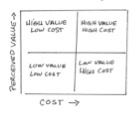Tis the season for home organization, cleaning up, and cleaning out. I, like many people, spent my time over the break battling the crowds at big box stores on a mission to take back my garage. As I stood stressing over the many storage shelving, racks, and container options I closed my eyes and pictured the items I was trying to contain. It suddenly hit me, what purpose are these things serving? Do they provide more value than the space they occupy? I instantly realized that instead of adding more stuff (storage), which would need to be assembled and maintained, I simply needed to eliminate until my belongings fit neatly on the two shelves I already had. So instead of a mountain of containers, I grabbed a simple wooden coat hanger and practically floated out of the store – giddy and liberated.
I am eager to apply this same thinking to operations within XPLANE. Organizations, ours included, tend to solve problems by adding things. We add process, systems, tools, roles, equipment, and endless other items to help us scale, automate, and hopefully become more efficient. Then we add more people, process and documentation on top to manage those things! None of this is bad, but like clutter on your countertop they build and can result in inefficiency and distraction to getting the important work done.
The start of the New Year is a great time to look at your organization with fresh eyes. There are a couple of ways you can exercise this thinking. The first is by doing an audit of your existing process, meetings, or systems etc. with a simple value matrix.
 Obviously your optimal quadrant is the upper left. Anything that falls in Low Value, High Cost should be eliminated and everything else is worth examining more closely. Can we design this so there is lower cost but the same value? Is the value worth keeping it around or is it just another thing to manage?
Obviously your optimal quadrant is the upper left. Anything that falls in Low Value, High Cost should be eliminated and everything else is worth examining more closely. Can we design this so there is lower cost but the same value? Is the value worth keeping it around or is it just another thing to manage?
The second way is to evaluate solutions through taking away vs. adding. It’s our natural inclination to want to solve something by adding process, roles, or systems but what if we considered taking something away instead? When trying to solve a problem, ask what if we removed a role, system, or requirement? What if we eliminated titles, timesheets, or performance reviews? Asking these questions will give you a new lens. Even if you decide to keep it you’ll likely uncover some deeper organizational root causes (culture or performance) that are being masked by additive solutions. And I bet that ultimately you’ll be led to a solution that is simpler, more direct and more … minimal.
Just like in your home, start by focusing on one problem or area that you can greatly influence rather than looking at the organization as a whole, which can be overwhelming. And be patient, as any veteran minimalist will tell you, the art of minimalism is an ongoing process and a journey.
